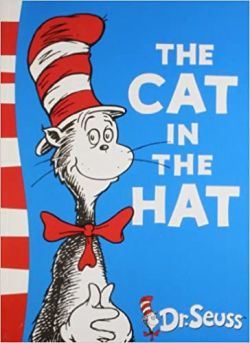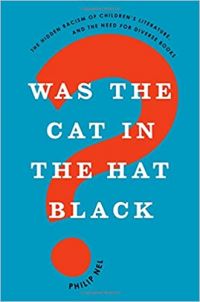The Cat in the Hat (1957)
The Cat in the Hat is a classic children's book written and illustrated by American author Theodor Geisel or mostly known as Dr. Seuss. By the time it was released in 1957, the Cat was an instant success and still captivating to children and the adults who read to them. Author of 100 Best Books for Children, Anita Silvey, mentioned that it has everything a classic needs — a great plot, great characters, wonderful illustrations and unique voice.
"Some books we read and we forget them right away," she says. "But there are those other books, that they just stay with us. And The Cat in the Hat is that kind of book."[1]
It proved as this book is sold over a million copies three years after its debut and listed as book number nine on list of best-selling children's book of all time published by Publishers Weekly in 2001. The Cat in the Hat also placed second on the New York Public Library's list of "Top 10 Checkouts of All Time" in 2020.[2]
The book was adapted into several media, including film, television, and theater.
Plot
The Cat in the Hat tells a story of two kids called Sally and Sam, who are left alone at home on a cold and rainy day while their mother goes out. They start their day the same as any other day and when they starting to feel bored, they staring wistfully out the window and wishing something interesting would happen.
And then suddenly they were visited by a mysterious cat. A tall anthropomorphic cat in a red and white-stripped top hat and a red bow tie, who assures them that their mother will not mind him being at their house.
The Cat also tell the children that he will entertain them with tricks that he knows. The children's fish refuses the cat offer and insist that the Cat need to leave. But the Cat then ignored the request by balancing the fish on the tip of his umbrella. The Cat tries a lot trickier trick when he balances himself on a ball and tries to balance many things on his limbs until he falls on his head, dropping everything he was holding. The fish admonishes him again, but the Cat just proposes another game. The Cat pull out two identical characters from huge red box he brings from outside and refers them as "Things", with blue hair and red suits called Thing One and Thing Two. The Things cause more trouble after its releases, like flying kites within the house, knocking pictures off the wall and picking out the children's mother's new polka-dotted dress. All the tricks and shows comes to an end when the fish sees the children's mother outside the window. In hurried, the boy catches the Things in a net and the Cat put them back within the huge box. He takes it out to front door as the fish and the children look around to see the mess he has made. When the Cat returns inside of the house, he rides a machine that picks everything up and cleans the house, which makes the fish and children happy. The Cat leaves the house just right before the children's mother returns home and the fish as well as the children are back where they started at the beginning of the story. When the mother comes inside, she asks the children what they did while she was out, but the children are hesitant and decided no to tell her their experience. The story ends with the question for the reader.
"What would you do if your mother asked you?"[3]
Controversy
The career of Dr. Seuss is described as complex and not easily summarized. He drew racist cartoons such as depicting Japanese-Americans as the enemy. Some of his early books also suffer from similar depiction and have been criticized for the way they portray people of color.
The Cat in the Hat also considered as racist although not explicitly racist as Dr. Seuss's other books. The main character of this book is based on a black woman who worked as an elevator operator. The cat character in the book, while he brings liveliness to two children on a dreary day, he is also clearly marked as if he does not belong in their white household. He threatens the stability of a white household and challenges the white social order. The clues to the cat’s black lineage have been covered up effectively that people need to carefully decoded to show how the story reflects subconscious white fear of black power.[4]
Philip Nel, a professor of English at Kansas State University who wrote a book-length study of Was The Cat In the Hat Black? mentioned that, "It’s actually kind of ordinary and that’s part of the point—racism is ordinary, it’s not aberrant, it’s not strange—and that’s why Seuss is useful to think about. He is an example of how even progressive, anti-racist people can act in ways that are racist. I don’t think he’s intentionally recycling stereotypes in his book from the ‘50s, but the imagination is influenced by the culture in which it grows, and it doesn’t necessarily filter out the racism bits during artistic creation.”
He thinks that images are powerful, and children could notice on levels that they may not be able to articulate. A persistence simplified depiction of a blackface, even in subtle ways, has a normalizing effect.[5]
References
- ↑ Neary, Lynn (March 2007). Fifty Years of 'The Cat in the Hat' : NPR. Retrieved 11 December 2020
- ↑ New York Public Library. "Top 10 Checkouts of All Time". Retrieved 11 December 2020
- ↑ The Cat In the Hat. Wikipedia. Retrieved December 17,2020.
- ↑ Murawski, John (August 2017). Is the ‘Cat in the Hat’ racist? Yes, and other kids books are too, professor says.. Retrieved 11 December 2020.
- ↑ Sawchuk, Stephen (October 2017). The Cat in the Hat’ Racist?. Retrieved on 11 December 2020.

